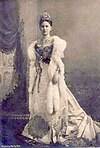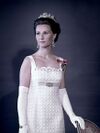Monarchy of Hellona: Difference between revisions
Pokemarick (talk | contribs) No edit summary |
Pokemarick (talk | contribs) |
||
| Line 73: | Line 73: | ||
The emblem of the Realm is the official symbol for the Hellonian Realm and its monarch. The symbol is a trefoil knot, known as a valknut (Hellonian: valknoop). Around the edges, there are three more points, making the valknut look like a full triangle. Furthermore, there are three triangles on the slopes of the valknut pointing outwards. It's a symbol that symbolizes the Asieren (gods of Asire) and is mostly associated with Wodan. As the king of Hellona has the religious authority over Asatru, it is also used as a symbol for Asatru, and is as such commonly used by Asatru shrines and temples, or otherwise incorporated into the shrine and temple emblems. | The emblem of the Realm is the official symbol for the Hellonian Realm and its monarch. The symbol is a trefoil knot, known as a valknut (Hellonian: valknoop). Around the edges, there are three more points, making the valknut look like a full triangle. Furthermore, there are three triangles on the slopes of the valknut pointing outwards. It's a symbol that symbolizes the Asieren (gods of Asire) and is mostly associated with Wodan. As the king of Hellona has the religious authority over Asatru, it is also used as a symbol for Asatru, and is as such commonly used by Asatru shrines and temples, or otherwise incorporated into the shrine and temple emblems. | ||
The three extra spikes were added during the age of exploration, with them symbolizing the three ways the Hellonian kingdom expanded. These three spikes would later be given the meaning of being a representation of a specific nation in the Hellonian Realm. The upper one represents the Servos Islands (later also Moundra and Tyrean), the upper-right one Lilotuka Island, the lower-right the Ebure Isles, the lower one Tirpitz and Batavia, the lower-left Norsund and the upper-left the Menako Islands. | |||
===Regalia=== | ===Regalia=== | ||
The royal regalia of Hellona are kept in the vaults of the Royal Treasury Chamber of the Hellonian Realm. The most important of the regalia are the crown, sword, orb and key. The crown is seen as an official representation of the leadership of the monarch, the sword represents the power of the monarch over his realm, the orb represents the realm itself and its connection to the heavens and the key is a symbol of the connection between the monarch and his peoples. | The royal regalia of Hellona are kept in the vaults of the Royal Treasury Chamber of the Hellonian Realm. The most important of the regalia are the crown, sword, orb and key. The crown is seen as an official representation of the leadership of the monarch, the sword represents the power of the monarch over his realm, the orb represents the realm itself and its connection to the heavens and the key is a symbol of the connection between the monarch and his peoples. | ||
| Line 81: | Line 82: | ||
The Royal Palaces, with several of them located outside mainland Hellona, are property of the government of each of the constituent countries. These palaces are at the disposal of the monarch, as arranged by the government of the country. Besides the state-owned property, the Royal Family also has several privately owned properties. | The Royal Palaces, with several of them located outside mainland Hellona, are property of the government of each of the constituent countries. These palaces are at the disposal of the monarch, as arranged by the government of the country. Besides the state-owned property, the Royal Family also has several privately owned properties. | ||
===Royal Palace=== | ====Royal Palace==== | ||
The '''Royal Palace''', also known as the '''Owidal Palace''', is the official residence of the monarch. The palace is located in the old city of [[Owidal]], the capital of [[Hellona]]. | The '''Royal Palace''', also known as the '''Owidal Palace''', is the official residence of the monarch. The palace is located in the old city of [[Owidal]], the capital of [[Hellona]]. | ||
The offices of the king, other members of the Royal Family, and the offices of the Royal Court are located in the palace. The Royal Palace is used for representative purposes and State occasions by the king. The Royal Palace is guarded by the Order of Free Warriors, a volunteer-only branch of the Hellonian Armed Forces. | The offices of the king, other members of the Royal Family, and the offices of the Royal Court are located in the palace. The Royal Palace is used for representative purposes and State occasions by the king. The Royal Palace is guarded by the Order of Free Warriors, a volunteer-only branch of the Hellonian Armed Forces. | ||
==List of Hellonian Monarchs== | ==List of Hellonian Monarchs== | ||
Revision as of 15:32, 6 April 2020
| King of Hellona | |
|---|---|
| Kᛟᚾᛁᛝ Vᚨᚾ ᚻᛖᛚᛚᚨᚾᚦ | |
 | |
| Incumbent | |
 | |
| Kristoffer since 7 October 1953 | |
| Details | |
| Style | His Majesty |
| First monarch | Björn Wodanerson |
| Formation | 1052 |
| Residence | Owidal Royal Palace |
| Appointer | Heredity |
The monarchy of Hellona, and by extension the monarchy of the Hellonian Realm, concerns itself with the monarchical head of state of Hellona and the Hellonian Realm. The monarchy exists within a system of constitutional and hereditary monarchy within a parliamentary democracy. The monarchy of contemporary Hellona finds its origin in the establishment of the kingdom by the legendary king Björn Wodanerson in the 5th century.
Modern-day hellona is a representative democracy with a parliamentary system based on the idea of popular sovereignty. These ideas are defined in the Charter for the Realm and the Instrument of Government of Hellona. The monarch and the members of the royal family undertake a variety of official, unofficial and other representational duties within the Realm and abroad
Constitutional role
The Hellonian Realm as a unified entity is a constitutional monarchy, of which King-Exalt Kristoffer is the current head of state. Although the powers of the monarch in the Hellonian state were greater, the role of monarch is nowadays limited to ceremonial and representative functions in the Hellonian Realm and abroad. Under the Instrument of Government of Hellona, the monarch lacks any formal form of political power anywhere in the Realm. In mainland Hellona, the monarch traditionally opens each parliamentary year, holds regular information councils with the Great-Minister and formally chairs the government of the Realm, His Majesty's Council, although this role is often delegated to the Great-Minister of Hellona. In addition, the monarch pays State Visits abroad and receive those incoming as hosts. The monarch and the Royal Family undertake a variety of other unofficial representative duties in Hellona, the Realm and abroad. The monarch also acts as head of the Asatru faith, hence the title of King-Exalt. Officially both titles are seen as separate and only held by the same person. Within the constitutional framework of Hellona, the monarch must always be of Asatru faith. The State itself is of secular nature constitutionally, although the country is overwhelmingly of Asatru faith.
Cultural role
Besides the tasks laid down in the constitutional documents of the Hellonian Realm, the monarch and Royal Family of the Realm also engage in other activities of Hellonian life. The most important of these is the participation in and the conduct of state visits. Other members of the Royal Family can also represent the country abroad at lesser events.
Many of the flag days of Hellona and the Realm have direct royal connotations; among them the birthdays of the King, the Queen-mother and, if applicable, the birthdays of other senior members of the Royal Family. None of these days are public holidays, however.
In addition to acting as the head of state, the monarch of Hellona also functions as head of the Asatru faith. This role is constitutionally seen as separate from the position of head of state, as the state itself is secular in nature. In practice, the position of head of state and the Exalt of the Asatruic faith are always in the hands of the same person. This means the monarch also engages in religious ceremonies and events as head of the faith. The most important of these is leading the annual Wodanblót in the Wodaner Temple in Owidal.
Titles
The full title of the Hellonian monarch is as follows:
In Hellonian; ᛒᛉ ᚦᛖ ᚷᛖᚾᚨᚦᛖ ᚦᛖᚱ ᚷᛟᚦᛖᚾ, Kᛟᚾᛁᛝ Vᚨᚾ ᚻᛖᛚᛚᚨᚾᚦ, ᚾᛟᚱᛋᚢᚾᚦ, ᛗᛖᚾᚨKᛟᛖᛈᛖᚾ, ᛚᛁᛚᛟᛏᚢKᚨ, ᛋᛖVᚱᛟᚾᛖᚾ, ᛏᛁᚱᛈᛁᛏZ ᛖᚾ ᛖᛒᚢᚱᛖᚾ, ᛒᛖᛋᚷᛖᚱᛗᚻᛖᛖᚱ ᛞᛖᚱ ᛗᛟᛖᚾᛞᛖᚱᛖᚾ ᛖᚾ ᛏᛉᚱᛖᚾ, Kᚱᛉᚷᛖᚱ ᛞᛖᛋ ᚹᛟᛞᚨᛋ ᛖᚾ VᛖᚱᚻᛖVᛖᚾᛖ ᛞᛖᚱ ᚨᛋᛋᚾᛏᚱᛟᚢᚹ; Bij de Genade der Goden, Koning van Helland, Norsund, Menakoepen, Lilotuka, Sevronen, Tirpitz en Eburen, Beschermheer der Moenderen en Tijren, Krijger des Wodans en Verhevene der Assentrouw
In English; By the Grace of the Gods, King of Hellona, Norsund, the Menako Islands, Tirpitz, Lilotuka Island, the Sevros Islands, the Ebure Isles, Protector of Moundra and Tyrean, Warrior of Wodan and Exalt of the Asatru faith
The full title of Hellonian monarchs changed in accordance to the growth or loss of Hellonian territory. Thus titles at times included king of Eburon and protector of Sconia.
The full title, however, is rarely used in the present day. Currently king Kristoffer uses the title of King-Exalt of the Hellonian Realm (Hellonian: Kᛟᚾᛁᛝ-VᛖᚱᚻᛖVᛖᚾᛖ ᚦᛖᚱ ᚻᛖᛚᛚᚨᚾᚦᛖᚱ ᚱᛉK; Koniŋ-Verhevene der Hellander Ryk). The kings and queens of the Hellonian Realm are addressed as 'Your Holy Majesty', whereas princes and princesses are referred to as His or Her Royal Highness, or His or Her Highness.
The customary title for the heir apparent is crown prince or princess. The wife of a crown prince would also receive a corresponding title, but not the husband of a crown princess.
Symbols of the monarchy
Royal emblem
The emblem of the Realm is the official symbol for the Hellonian Realm and its monarch. The symbol is a trefoil knot, known as a valknut (Hellonian: valknoop). Around the edges, there are three more points, making the valknut look like a full triangle. Furthermore, there are three triangles on the slopes of the valknut pointing outwards. It's a symbol that symbolizes the Asieren (gods of Asire) and is mostly associated with Wodan. As the king of Hellona has the religious authority over Asatru, it is also used as a symbol for Asatru, and is as such commonly used by Asatru shrines and temples, or otherwise incorporated into the shrine and temple emblems.
The three extra spikes were added during the age of exploration, with them symbolizing the three ways the Hellonian kingdom expanded. These three spikes would later be given the meaning of being a representation of a specific nation in the Hellonian Realm. The upper one represents the Servos Islands (later also Moundra and Tyrean), the upper-right one Lilotuka Island, the lower-right the Ebure Isles, the lower one Tirpitz and Batavia, the lower-left Norsund and the upper-left the Menako Islands.
Regalia
The royal regalia of Hellona are kept in the vaults of the Royal Treasury Chamber of the Hellonian Realm. The most important of the regalia are the crown, sword, orb and key. The crown is seen as an official representation of the leadership of the monarch, the sword represents the power of the monarch over his realm, the orb represents the realm itself and its connection to the heavens and the key is a symbol of the connection between the monarch and his peoples.
The only time the regalia are used in the present day is during the coronation of the monarch. They were originally also displayed during the opening of the parliamentary year, but this tradition was abandoned by queen Amalia.
Royal residences
The Royal Palaces, with several of them located outside mainland Hellona, are property of the government of each of the constituent countries. These palaces are at the disposal of the monarch, as arranged by the government of the country. Besides the state-owned property, the Royal Family also has several privately owned properties.
Royal Palace
The Royal Palace, also known as the Owidal Palace, is the official residence of the monarch. The palace is located in the old city of Owidal, the capital of Hellona.
The offices of the king, other members of the Royal Family, and the offices of the Royal Court are located in the palace. The Royal Palace is used for representative purposes and State occasions by the king. The Royal Palace is guarded by the Order of Free Warriors, a volunteer-only branch of the Hellonian Armed Forces.
List of Hellonian Monarchs
| Name | Portrait | Arms | Birth | Marriages | Death | Claim | Ref. |
|---|---|---|---|---|---|---|---|
| Christian II Christian II Agnarr Erik Andersson 12 March 1715 – 25 November 1778 (63 years) |

|

|
7 September 1702 Owidal Son of Oscar and Juliana |
Juliana Wodaner Temple 10 March 1730 2 children |
25 November 1778 Owidal aged 76 |
Son of King Oscar | |
| Nicholas II Nicholas II Hildebran Erik Krisson 25 November 1778 – 6 May 1828 (50 years) |

|

|
9 June 1753 Owidal Son of Christian II and Juliana |
Sonja Wodaner Temple 10 March 1774 6 children |
6 May 1828 Owidal aged 75 |
Son of King Christian II | |
| Christian III Christian III Alexander Siegfried Nikolson 6 May 1828 – 20 January 1884 (56 years) |

|

|
16 May 1797 Rökavik Royal Estate Son of Nicholas II and Sonja |
Alexia Wodaner Temple 5 August 1805 5 children |
20 February 1884 Owidal aged 87 |
Son of Nicholas II | |
| Amalia Amalia Juliana Krisdotter 20 February 1884 – 11 December 1928 (44 years) |

|

|
8 January 1849 Owidal Daughter of Christian III and Alexia |
Charles Wodaner Temple 3 June 1879 No children |
28 May 1934 Owidal aged 85 |
Daughter of King Christian III | |
| Estelle Estelle Elisbet Agnes Amadotter 11 November 1928 – 7 October 1953 (25 years) |

|

|
14 December 1889 Owidal Daughter of Queen Amalia and Prince William |
Princess Ingrid Alina Wodaner Temple 26 July 1930 |
Living Age 70 years |
Daughter of Queen Amalia | |
| Kristoffer Kristoffer Seger Esterson 7 October 1953 – Present (7 years) |

|

|
18 April 1928 Rökavik Son of Nicholas Alexander and Ingrid Bergstrom, adopted by Estelle |
Elena of Hellona Wodaner Temple 20 November 1958 |
Living Age 31 years |
Adopted son of Queen Estelle |